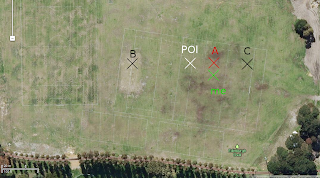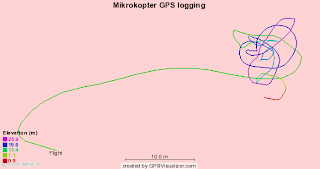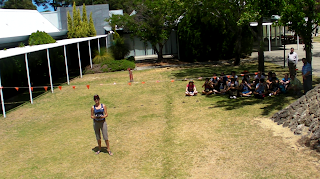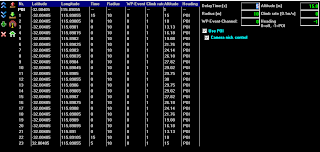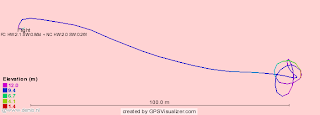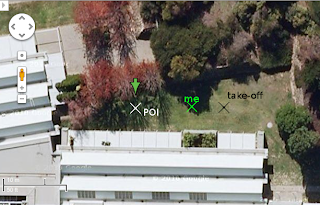The plan today was to test two things: altitude control and curved vs. straight flight paths. I planned four sets of waypoints:
- Vertical ascent at point A in steps of 5m, with 5s delays in between each waypoint, up to a height of 20m
- Vertical ascent at point A in steps of 5m, with no delays, up to a height of 20m
- Curved flight from B to C, pointing at POI
- Straight flyover from B to C, pointing at POI
The temperature was 30C and the wind was moderate and steady: 16 knots, SE. It was mostly sunny.
Flight 1 - Vertical ascent with delays @ A
Start 14:47:48
I started the 'copter a little south of location B, while I stood slightly further to the south. I performed the pre-flight checks, started the motors and sent it up a few meters, then engaged waypoint mode. As it moved to point A, I also moved to the 'me' location. It ascended in altitude steps but seemed to take a long time to do each step. Brought it down nicely.
End 14:49:53
I decided not to perform the vertical ascent without delays until I could ascertain whether the first programmed flight corresponded well to the measured flight, from the logs.
Flight 2 - Curved flight path B -> C
Start 14:59:34
I was at the 'me' location and the 'copter was at point A. I performed the pre-flight checks, started the motors and sent it up a few meters, then engaged waypoint mode. It moved smoothly to B, but the next waypoint steps were not smooth, and it took a long time to move over the flight path, even with no delays set. Not as bad as with 7 propellers but still need to come up with better Radius/PID settings. I aborted the flight about 20m East of point B and brought it down safely.
End 15:02:35
Flight 3 - Straight flyover B->C
Start 15:09:03
I was at the 'me' location and the 'copter was at point A. I performed the pre-flight checks, started the motors and sent it up a few meters, then engaged waypoint mode. It moved smoothly to B, but kept ascending once it was there, up to an estimated height of 50 meters. I realised I had the throttle at 55% instead of 50% so it just went up-and-up, until I realised, reduced the throttle, and brought it down. It was supposed to fly over at 15m altitude, but it did not begin its waypoint until about 5m. As it was so close to the ground, I set it to PH/AH and brought it down instead. I need to check logs to find out how high it
thought it was when it started to execute the waypoint.
End 15:10:55
Results
The first interesting result is that the 'copter does not appear to log until waypoint mode is engaged. Thus some flight logs, such as the first flight, do not have data points until 9m altitude, the point at which I engaged the waypoint mode.
Flight 1

It's hard to measure the time spent at each altitude as the 'copter doesn't seem to be able to stay exactly at the right altitude. It also didn't reach 30m. It's possible that because I have 'radius' set to 10m, the 'copter thinks that when I tell it to climb to 15m or 20m, and it is already at 10m, it thinks it is close enough, and doesn't bother to climb until the 25m waypoint kicks in. Then it ascends to 25m, reads the 30m waypoint, but thinks it's close enough, so just hovers for 15 seconds. For some reason it then descends to 20m and pauses there. So 5m increments may simply be too fine for the 'copter to manage.
One might also guess from the birds-eye projection of this flight that the x,y position r.m.s. is around 8m. But taking the standard deviation of the logged latitudes and longitudes shows that the r.m.s. is more like 2.3m, which is a good measurement to have made. This would be excellent to measure again on a cool, still day.
I also made a histogram of the position offsets in latitude and longitude. The average of the longitude position offsets was 0.3m (east) and the average of the latitude position offsets was 1.4m (north). This suggests that the wind was probably blowing more from the south at altitude, pushing the 'copter slightly to the north.
Flight 2
Looking at the flight log, the 'copter took about 25 seconds to 'find' a waypoint to sufficient accuracy, which was usually between 5-10m away from the right position. The strong breeze no doubt made it more difficult - it would be informative to run the same test on a very still day. It may also be useful to set the allowable 'Radius' to 20m, to see if the 'copter spends less time trying to get to the waypoint, even if it doesn't get the waypoint exactly right.
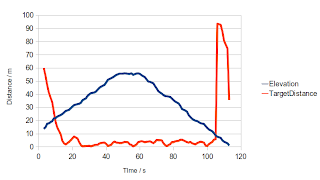 Flight 3
Flight 3
There is a "TargetDistance" column in the GPX file, which I think refers to the distance away from the next waypoint. From the previous flights I couldn't tell if it took into account altitude, but from this flightlog, one can see the TargetDistance staying low, even as the altitude significantly deviates from the expected waypoint. This is another argument in favour of performing straight flyovers, since if we keep the elevation steady, then we correctly log how far away the next target is.
The point at which the TargetDistance suddenly increases is when the 'copter reaches the radius of Waypoint B, and then decides it needs to move to Waypoint C. This is at just 8m altitude, and the 'copter was still descending, and when the 'copter does a course-correction it usually does drop slightly as it changes power in its motors. The elevation it was supposed to use was 15m, but 8m is only 7m less than this, and the allowed radius was 10m, so actually this scary-looking behaviour was fairly reasonable.
In terms of getting more reliable altitude behaviour, I need to read up
the documentation, and get a bit better at judging heights rather than relying entirely on autopilot. The 'copter tripled its height before I decided to bring it down again; it should have been clear after 20 seconds that something was wrong. It's also probably a good idea to test the straight flyover at a higher altitude than 15m if I continue to use a radius of 10m for the waypoints, since that gives us only a minimum of 5m clearance above the ground. 20-30m would be safer, and more similar to actual field conditions of 100m.
Overall
I thought from a previous comparison of the logs that the KML files contain a log every second, and that the GPX files contain a log every 2.5 seconds. However I found this time that there was some jitter around these numbers. I can't tell which one is 'off' because the GPX files only contain the time to the nearest second, and the KML files have no time logged at all. It's hard to get sub-second accuracy using any other equipment such as a stopwatch, due to human reaction time. What might be a good idea is to set the KML logging to say, 10 seconds, and the GPX logging to 1 second, and see if I get a good GPX log every second.
Overall, the camera tilt seemed too high - the servo adjustments I made appear to have gone too far. I need to set up a waypoint on the ground, and go to several different altitudes at the same point, and see if the camera still points in the correct direction. If not, I should adjust the servo settings again. It might be possible to do this in the lab just by picking it up and tilting it - something to hold it in place would be useful.
One thing that would make flight set-up easier would be to have some device to find out where the POI is. The car GPS was too low-accuracy. Maybe I should simply have a first-flight program which simply flies to the POI to be used for the rest of the flights.
Further Flights
- On a still day:
- Measure r.m.s. position accuracy by hovering or moving between vertical waypoints;
- Run the curved flight path with lower and higher radii;
- On any day:
- Mess with the altitude controls and see if I can get 5m precision;
- Get the servo mount settings correct by ascending to a series of known altitudes and check the pointing via a video camera;
- Run the straight flyover with waypoints at at least a height of (Radius + 10) m to allow for the 'copter's uncertainty in altitude;
- Change the logging settings:
- Reduce the KML to intermittent and see if GPX logging is more frequent;
- Reduce both to prime intervals (e.g. 3, 5) so that they don't overlap frequently and see if they are more consistent.

